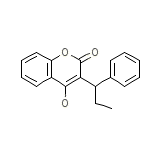Phenprocumone




Categorie
Phenprocumone Les marques, Phenprocumone Analogs
Phenprocumone Les marques melange
Phenprocumone Formule chimique
C18H16O3
Phenprocumone RX lien
No information avaliable
Phenprocumone FDA fiche
Phenprocumone msds (fiche de securite des materiaux)
Phenprocumone Synthese de reference
Aucune information disponible
Phenprocumone Poids moleculaire
280.318 g/mol
Phenprocumone Point de fusion
179.5 oC
Phenprocumone H2O Solubilite
12,9 mg / L
Phenprocumone Etat
Solid
Phenprocumone LogP
4.59
Phenprocumone Formes pharmaceutiques
Tablet
Phenprocumone Indication
Utilisé pour la prévention et le traitement des maladies thromboemboliques, y compris la thrombose veineuse, embolie, et l'embolie pulmonaire ainsi que pour la prévention de l'AVC ischémique chez les patients atteints de fibrillation auriculaire (FA).
Phenprocumone Pharmacologie
Phenprocoumone, un anticoagulant coumarine, fluidifie le sang par les antagonistes de la vitamine K qui est nécessaire pour la production de facteurs de coagulation dans le foie. Anticoagulants tels que la phenprocoumone n'ont aucun lien direct effet sur un thrombus établie, pas plus qu'ils ne inverser les lésions ischémiques (dommages causés par une irrigation sanguine inadéquate à un organe ou partie du corps). Cependant, une fois un thrombus a eu lieu, l'objectif du traitement anticoagulant est d'empêcher extension du caillot formé et prévenir les complications thromboemboliques secondaires qui peuvent entraîner des séquelles graves, voire mortels.
Phenprocumone Absorption
La biodisponibilité est proche de 100%
Phenprocumone Toxicite
50 = 500 mg / kg. Les symptômes de surdose comprennent suspectée ou manifeste des saignements anormaux (par exemple, l'apparition de sang dans les selles ou les urines, hématurie, des saignements menstruels excessifs, méléna, pétéchies, ecchymoses ou excessive persistante suintant de blessures superficielles).
Phenprocumone Information pour les patients
The objective of anticoagulant therapy is to decrease the clotting ability of the blood so that thrombosis is prevented, while avoiding spontaneous bleeding. Effective therapeutic levels with minimal complications are in part dependent upon cooperative and well-instructed patients who communicate effectively with their physician. Patients should be advised: Strict adherence to prescribed dosage schedule is necessary. Do not take or discontinue any other medication, including salicylates (e.g., aspirin and topical analgesics), other over-the-counter medications, and botanical (herbal) products (e.g., bromelains, coenzyme Q10, danshen, dong quai, garlic, Ginkgo biloba, ginseng, and St. John's wort) except on advice of the physician. Avoid alcohol consumption. Do not take phenprocoumon during pregnancy and do not become pregnant while taking it. Avoid any activity or sport that may result in traumatic injury. Prothrombin time tests and regular visits to physician or clinic are needed to monitor therapy. Carry identification stating that phenprocoumon is being taken. If the prescribed dose of phenprocoumon is forgotten, notify the physician immediately. Take the dose as soon as possible on the same day but do not take a double dose of phenprocoumon the next day to make up for missed doses. The amount of vitamin K in food may affect therapy with phenprocoumon. Eat a normal, balanced diet maintaining a consistent amount of vitamin K. Avoid drastic changes in dietary habits, such as eating large amounts of green leafy vegetables. Contact physician to report any illness, such as diarrhea, infection or fever. Notify physician immediately if any unusual bleeding or symptoms occur. Signs and symptoms of bleeding include: pain, swelling or discomfort, prolonged bleeding from cuts, increased menstrual flow or vaginal bleeding, nosebleeds, bleeding of gums from brushing, unusual bleeding or bruising, red or dark brown urine, red or tar black stools, headache, dizziness, or weakness. If therapy with phenprocoumon is discontinued, patients should be cautioned that the anticoagulant effects of phenprocoumon may persist for about 2 to 5 days.
Phenprocumone Organismes affectes
Les humains et autres mammifères














